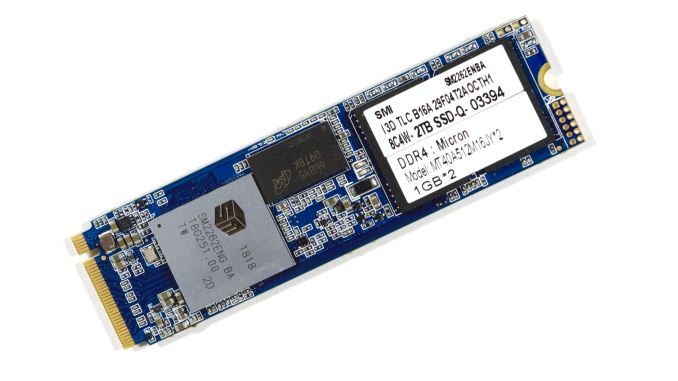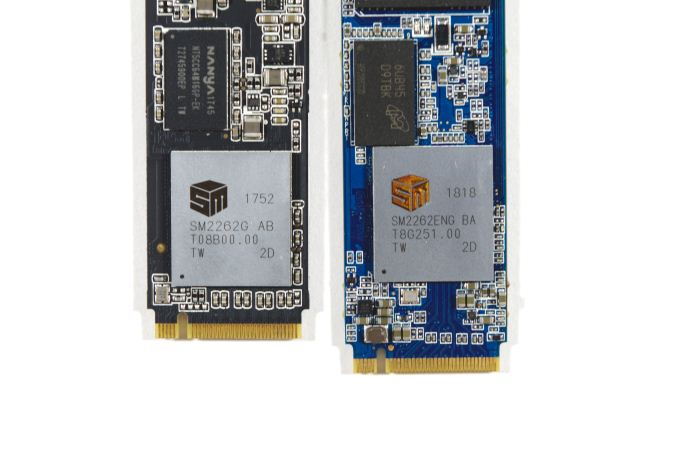The Silicon Motion SM2262EN SSD Controller Preview: Good And Bad Amplified
by Billy Tallis on August 1, 2018 11:45 AM EST
Silicon Motion's second-generation NVMe SSD controllers have all but taken over the consumer NVMe SSD market. Drives like the HP EX920 and ADATA SX8200 currently offer great performance at prices that are far lower than what Samsung and Western Digital are charging for their flagship products. These Silicon Motion-based SSDs are using the SM2262 controller - the high-end member of SMI's current lineup - but they're almost as cheap as the entry-level NVMe drives that use low-end controllers with limited performance. Phison's second-generation high-end E12 controller still hasn't hit the shelves, so Silicon Motion has no serious competition for the SM2262.
But Silicon Motion isn't standing still. They've prepared an update to the SM2262 controller called the SM2262EN. This was first previewed at the same time that the SM2262 was announced, but Silicon Motion didn't provide much guidance on the timing. The SM2262 controller hit the market with the Intel SSD 760p in January, and the SM2262EN is almost ready for release. With the SM2262EN, Silicon Motion is promising substantial performance improvements that go well beyond what we usually see from firmware optimizations, though the hardware changes relative to the SM2262 are minimal. The updated controller should hit the market in time to compete against Phison E12 SSDs and the first wave of drives with 96-layer 3D NAND.
| Silicon Motion NVMe SSD Controller Comparison | |||||
| Controller | SM2262EN | SM2262 | SM2263 | SM2263XT | SM2260 |
| Host Interface | PCIe 3.0 x4 | ||||
| Protocol | NVMe 1.3 | NVMe 1.2 | |||
| NAND Flash Channels | 8 | 8 | 4 | 4 | 8 |
| NAND Chip Enable lines | 4 | 4 | 4 | 4 | 4 |
| NAND interface speed | 800 MT/s | 667 MT/s | 533 MT/s | ||
| Typical NAND | IMFT 64L 3D TLC | IMFT 32L 3D MLC/TLC | |||
| DRAM Support | DDR3(L), LPDDR3, DDR4 |
No (HMB* supported) |
DDR3(L), LPDDR2 |
||
| DRAM Bus Width | 32/16-bit | 16-bit | N/A | 32/16-bit | |
| Controller Package | 18x16mm 472-ball TFBGA |
12x12mm 288-ball TFBGA |
18x16mm 472-ball TFBGA |
||
| Sequential Read MB/s | 3500 | 3200 | 2400 | 2400 | 2400 |
| Sequential Write MB/s | 3000 | 1900 | 1700 | 1700 | 1000 |
| Random Read IOPS | 420k | 370k | 300k | 280k (HMB*) 120k (no HMB*) |
120k |
| Random Write IOPS | 420k | 300k | 250k | 250k | 140k |
| *HMB = Host Memory Buffer - where an SSD uses system DRAM to save cost by not having any of its own | |||||
To assess the new SM2262EN controller solution, Silicon Motion has provided us with a 2TB reference design SSD with their latest firmware, a work in progress as Silicon Motion continues to optimize performance. This is a higher capacity drive than any of the SM2262 SSDs we've tested, and some performance improvement may be due simply to the capacity increase. However, even at 1TB we already have several NAND dies on each of the controller's 8 channels, so adding more dies shouldn't have a huge impact, especially not for sequential transfers.
| SM2262EN Engineering Sample Specifications | |
| Usable Capacity | 2000 GB |
| Controller | Silicon Motion SM2262EN |
| Firmware Version | SVN112 |
| NAND Flash | Intel 64-layer 256Gb 3D TLC |
| Form-Factor | double-sided M.2 2280 |
| Interface | PCIe 3 x4 |
| DRAM | 2GB Micron DDR4-2400 CL16 |

SM2262 (left) and SM2262EN (right)
This 2TB configuration represents the maximum practical capacity when using 256Gb NAND dies, as it requires four packages with stacks of sixteen dies. The usable capacity is configured as about 2000 GB. The PCB layout is generally the same as for the SM2262 drives we've seen, with one DRAM package and two NAND packages on each side. This drive uses 2GB of Micron DDR4 DRAM, while all of the SM2262 retail drives we've seen use DDR3L.
The switch to DDR4 gives a slight improvement to voltage and latency, and a big boost to throughput—which is probably necessary to make the most of the EN controller variant. The use of DDR4 does add slightly to the cost of the drive, but not enough to prevent this change from carrying over into retail products. The DRAM update still leaves Silicon Motion a bit behind Samsung, which has moved its SSDs to LPDDR4 and reaped significant power savings.
For this review, the 2TB SM2262EN drive is compared against other recent NVMe SSDs, primarily high-end drives. The results from our engineering sample of the upcoming Phison E12 controller are also included, and these two new controller solutions will probably be responsible for the stiffest competition in the NVMe SSD market segment once they are both shipping in volume.
| AnandTech 2018 Consumer SSD Testbed | |
| CPU | Intel Xeon E3 1240 v5 |
| Motherboard | ASRock Fatal1ty E3V5 Performance Gaming/OC |
| Chipset | Intel C232 |
| Memory | 4x 8GB G.SKILL Ripjaws DDR4-2400 CL15 |
| Graphics | AMD Radeon HD 5450, 1920x1200@60Hz |
| Software | Windows 10 x64, version 1709 |
| Linux kernel version 4.14, fio version 3.6 | |
| Spectre/Meltdown microcode and OS patches current as of May 2018 | |
- Thanks to Intel for the Xeon E3 1240 v5 CPU
- Thanks to ASRock for the E3V5 Performance Gaming/OC
- Thanks to G.SKILL for the Ripjaws DDR4-2400 RAM
- Thanks to Corsair for the RM750 power supply, Carbide 200R case, and Hydro H60 CPU cooler
- Thanks to Quarch for the XLC Programmable Power Module and accessories
- Thanks to StarTech for providing a RK2236BKF 22U rack cabinet.











28 Comments
View All Comments
Billy Tallis - Wednesday, August 1, 2018 - link
The sustained I/O synthetic tests move far too much data for DRAM caching of user data to have much impact. The burst I/O tests could theoretically benefit from using DRAM as a write cache, but it doesn't look like that's the case based on these results, and I don't think Silicon Motion would really want to add such a complication to their firmware.leexgx - Saturday, August 4, 2018 - link
don't think any SSD has used the DRAM as cache (only used for PAGE table) i could speed things up a little but your still limited by the NAND speed any way, Writing directly to NAND makes more senseMikewind Dale - Thursday, August 2, 2018 - link
That drop in performance in the Heavy test, going from empty to full, was horrifying. I'd like to see some additional tests where the drive gets progressively closer to full. At what point does the drive's performance plummet? Is it gradual or sudden?With other drives, it doesn't matter so much. Most of them have approximately (within 10-20%) the same performance when empty or full, so a person using a full drive will still get approximately the same experience no matter how much they use the drive. But the SM2262EN loses about 80%(!!!!) of its performance when full. So it would be important to know how quickly or gradually this loss occurs as the drive fills.
jjj - Thursday, August 2, 2018 - link
Any chance you are going to the Flash Memory Summit? Might be an interesting year.Billy Tallis - Thursday, August 2, 2018 - link
Yep, we'll be at FMS next week. Tuesday is going to be a very busy day.jjj - Thursday, August 2, 2018 - link
Great, looking forward to your reports!Death666Angel - Thursday, August 2, 2018 - link
Considering this thing is still in a beta state, I don't think any further investigation into the full state performance is beneficial to us consumers. But if a SM2262EN SSD hits the shelves and is buyable, then a look into different states of fullness and the corresponding performance will be greatly appreciated. :D Good test and SSD controller so far.DigitalFreak - Thursday, August 2, 2018 - link
I would definitely like to see this with a retail drive.iwod - Thursday, August 2, 2018 - link
So have we reached peak SSD? If even Optane don't give us any user perceived performance, then surely user would choose larger capacity SSD than 3GB/s vs 2GB/s SSD.Right now we need price to drop faster. 500GB PCI-E SSD with 1GB/s + Speed should be under $100.
rpg1966 - Thursday, August 2, 2018 - link
"Silicon Motion's second-generation NVMe SSD controllers have all but taken over the consumer NVMe SSD market. Drives like the HP EX920 and ADATA SX8200 currently offer great performance at prices that are far lower than what Samsung and Western Digital are charging for their flagship products."This (kind of) implies that the controller is the biggest cost element of a drive. Does anyone have a rough breakdown of parts costs for a drive like this, i.e. controller, DRAM, NAND, and the board+ancillaries?